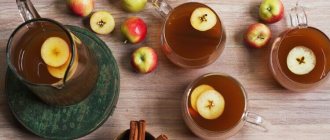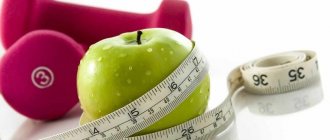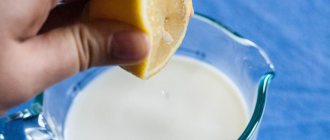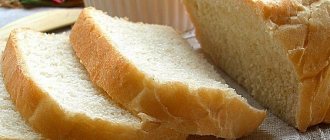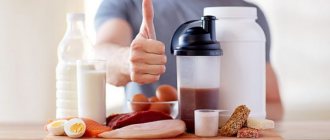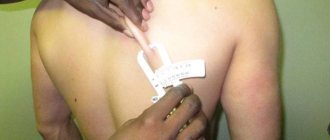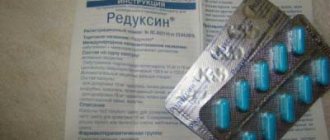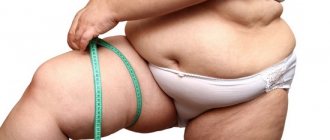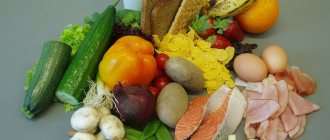At the moment, scientists have developed a huge number of different diets. However, one of them is worth talking about separately. This is the LCHF no-hunger diet. A real scientific breakthrough made by Andreas Enfeldt back in early 2000 simply overturned all the truths of proper nutrition that existed before that time. He completely refuted the knowledge that the appearance of excess weight in the body is not caused by a large consumption of fats, but rather by carbohydrates. Based on this fact, the nutritionist developed a special weight loss program, which became a real revolution in food. The LCHF no-hunger diet has been considered one of the most effective for many years. This is exactly what we will talk about in this article.
The essence of the diet
To better understand what the low-carbohydrate diet LCHF is, let’s decipher this abbreviation. If we translate it from English, the meaning will be: “low carbohydrates - high fat.” This is precisely the essence of such nutrition. So, it is necessary to include as few foods containing carbohydrates as possible in your diet, replacing them with fats.
All this led to the fact that this nutrition plan received another name, which is better known among adherents of weight loss: the ketogenic diet LCHF. In some ways, such a name is quite understandable, since using a diet consisting almost entirely of fats, the body, when processing them, receives energy not from carbohydrate breakdown products, as usual, but from ketones. Moreover, as it was found out, they are quite good sources of energy, since they are able to metabolize in the body for a long time so that a person does not experience a loss of strength.
Coconut oil coffee recipe
The LCHF popular diet includes a variety of coffee recipes. Drinks provide a powerful boost of energy. Coffee contains fats that provide a feeling of fullness. The drink helps fight the urge to snack. In addition, coffee helps improve intestinal functions.
The drink, which is part of the LCHF low-carb diet, is prepared as follows:
- You need to brew coffee in a Turk according to a traditional recipe.
- After this, add 2 teaspoons of butter and coconut oil per 200 ml of water.
- Beat the drink with a mixer until smooth.
Nutrition rules

If you decide to create a LCHF diet menu yourself, then you should definitely know what proportions of products you will need to take. The entire daily diet should consist of 70 percent exclusively fat, with the remaining 30 percent coming from 20 percent protein and 10 percent complex carbohydrates. By receiving only such foods, the body is deprived of the usual sugars that are used to saturate the body with energy. This is how the breakdown of your own fat reserves gradually begins. This ultimately leads to weight loss.
In addition, the increase in the amount of fat in the diet is what, according to reviews, distinguishes the LCHF diet from other low-carbohydrate diets, since in them the amount of carbohydrates is usually reduced due to an increase in the proportion of proteins. However, even if the Dukan diet or the famous “Kremlin” diet help you lose weight, they can negatively affect your health. Scientists have found out that if most of the food entering the body is protein, then to obtain energy it will be necessary to take it from the breakdown products of proteins, which harms the condition of the kidneys and liver. This way you will actually be able to lose weight, but the weight will very quickly come back in even greater quantities.
Ketones suppress appetite
In addition to the fact that ketone bodies can be partially used by cells as fuel when “hungry days” arrive, they also suppress appetite. By sending signals to the brain, they affect the satiety center and block the desire to eat. However, scientists have calculated that in order for ketone levels to be high enough to provide their purported weight loss benefits, daily carbohydrate intake must be reduced very radically. These are carbohydrates that approximately one apple contains. Then all the benefits of ketones will be fully realized.
Therefore, experts do not praise this diet and are in no hurry to assign it the title of “safe and effective.” The ketogenic diet is extremely restrictive and is not suitable for everyone because it is low in carbohydrates, a source of fuel for cells.
The original ketogenic diet requires that 85 to 90% of daily calories come from fat, 8 to 10% from protein, and as little as possible from carbohydrates. Modern approaches typically increase protein to 100 to 120 grams, or 20 to 30% of calories, but higher protein levels do not produce as much ketosis. And the effect is no longer the same.
Tips and tricks

You should definitely prepare for the fact that the LCHF diet is strict, and therefore, despite the fact that you can eat a fairly large number of calories per day, it is not easy to get used to it. It will be especially painful for those with a sweet tooth to adhere to such a nutrition plan, since they will have to completely give up baking or sweets.
But in general, the rules of this diet are quite simple, you just need to follow these recommendations:
- You should completely avoid any fast food. All pizzas, pies, fries and other products sold in fast food cafes are completely prohibited, despite the fact that they contain a lot of fat.
- However, there are no restrictions on the weight of portions, so during the diet you won’t have to feel hungry, because you can eat as much as your heart desires. The main thing is not to deviate from the above ratio of fats, carbohydrates and proteins.
- Judging by the reviews, on the LCHF diet you need to eat only when you immediately feel hungry. If you don’t have it, then you don’t need it, so you should adjust your meals to your own feelings.
- It is very important to limit the amount of fresh fruit you eat per day. Yes, they are really healthy, since they contain a large amount of vitamins and other useful substances, but they should be consumed exclusively as dessert in small quantities due to the high sugar content.
- Your diet must include foods that contain large amounts of fiber. If this cannot be done, then you can buy a ready-made biological additive with this substance in the store. This is necessary in order to prevent disruptions in the digestive tract that may begin to occur when switching to a new diet plan.
- When using the LCHF diet menu, it is imperative to remove alcohol from the diet, including on important holidays. It was found that even low-alcohol drinks - like beer - effectively prevent the breakdown of fat, which prevents further weight loss. Therefore, it is best to simply drink water. Nutritionists advise drinking one glass about half an hour before meals, and the rest of the time drinking only when thirst begins.
- It is quite difficult to burn excess fat solely through nutrition, so you should also definitely start exercising. Even very short workouts each day will noticeably improve the results a person gets from their diet.
More than three weeks with a minimum of carbohydrates
Since I decided to switch to LCHF on Monday, September 21, and made the decision late in the evening on Sunday, September 20, I didn’t have much time to prepare. As a result, on the first day my diet was very meager: eggs, chicken fillet, cucumber and tomato salad, cheese. Moreover, I was also quite undernourished, and it was a training day, and a hard one - legs. On the other hand, last weekend I went on a massive binge and seriously went overboard on calories. So he compensated for the uneaten Sunday gluttony.

The macronutrient breakdown looks like this:

On the first day, in general, the condition was normal, only in the evening it somehow became cloudy, or rather foggy. An incomprehensible state is neither good nor bad. Although, after a powerful workout and a sudden change in diet, this is normal.
Most of all, I was afraid that due to the lack of glucose in the usual amount, my brain would begin to dull and I would not be able to work normally. And all the work is connected with mental activity (no matter what they say, “everyone can write articles” - try it first before judging). In general, on Tuesday I was really stupid, but this was expressed not in a decrease in intellectual abilities, but in forgetfulness.
So, I forgot to take my wife’s training things with me to the gym (she goes there right after work), and only took water for her, for some reason deciding that my beloved took everything with her (although she had never had such a practice before). During the training process, one exercise simply flew past my consciousness and in the end I thought that I needed to do another one, while in fact all six planned movements were completed.
On Wednesday, I also felt like I was in a fog, although I was working normally, and I didn’t have any special complaints about some really cloudy state. By the way, glycogen reserves in the muscles and liver (formed from carbohydrates and provide energy for the body to function) are usually used up within two days if you consume very few carbohydrates.
On Thursday morning , the fourth day of low-carb, I felt as if my body had been turned on. Some kind of switch went off inside and the body began to work as before - clear consciousness, good health, no state, as if you were in a fog. As I understand it, the body did enter ketosis mode and began to actively use ketones as an energy source. Life was getting better, as was the diet .
The remaining three days of the first week on a low-carb diet went well physically. I can only note the bad sleep, but in the first three days it was clearly due to the fact that I had a slight cold (no fever or cough, but I felt bad in my throat). And then some life difficulties happened, which could also negatively affect sleep. In any case, since Monday of the second week on LCHF, I have already slept normally, and my diet has finally formed.
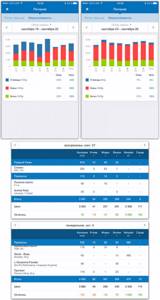
How has the diet changed in terms of carbohydrate intake and the amount of macronutrients in the diet now?
What were the changes in your body over the week?
It took 4–4.5 liters of water. That is, on Sunday morning, September 20, I weighed 107.5 kg , and on Monday a week later - 103 kg .
Why exactly did the water go away? Muscles do not burn so quickly if the diet is high in calories and there is physical activity. Fat also does not disappear at such a speed, no matter what citizens who are losing weight or dreaming of losing weight may think. But water is lost once or twice, since carbohydrates retain it in the body (4 g of water for every gram of carbohydrates received with food), and since there are no carbohydrates, then there is no additional water. In addition, in the first couple of nights I ran to the toilet very actively. In the second week, the weight stabilized at 102.5–103.5 kg.
What is the general feeling?
I’m not particularly drawn to sweets, flour, or candy. The reason for this is the absence of hunger in principle. And this despite the fact that on average I began to eat 4 times a day (instead of six, or even seven, if with snacks), of which one is a snack such as coffee and cream (80–100 g of 35 percent). Although on training days I drink an additional portion of protein an hour before training.
In general, I started all this to increase work productivity. The fact is that in the second half of the day I was literally exhausted - I fell asleep, I had to work through force. If you sleep for 30–40 minutes during the day, you can seem to perk up, but often there was the opposite effect. The reason for this could be insulin spikes due to carbohydrates (especially after oatmeal or rice) when blood sugar dropped below average. With LCHF nutrition, there are no sharp jumps in blood sugar levels, which means it doesn’t make you sleepy. This is also the reason for the lack of hunger combined with the rather slow digestion of protein and fatty foods.
So, I really don’t feel overwhelmed in the second half of the day, my head remains clear, you work calmly and at ease. Yes, tiredness and tiredness, of course, are felt at the end of the day, but not as critical as before. That is, you can write something sane at 9 o’clock in the evening, and at 10, and even after a hard workout, without eating chocolate or other sweets for this.
It is also worth noting the onset of peace in the gastrointestinal tract (GIT). Sorry for the details, but now there is no feeling of bloating, heaviness, no “bloating or sausage.” Although I thought that highly fatty foods should do just the opposite (at least a heaviness in the stomach, but it doesn’t). It took about a week and a half for the gastrointestinal tract to adapt to the new realities. Nothing extreme, like intestinal upset, but there were some nuances. Non-critical, so I won't focus on them.
What's with the training?
Strength has not decreased much, nor has the volume of training, except that muscle failure occurs a little faster and more sharply. I think this is due to the fact that the body is still adapting to new realities in nutrition. For example, with a large amount of carbohydrates in my diet, I squatted in a Smith machine (barbell on the shoulders) with 120 kg for three working approaches of 12 times, and on a low-carbohydrate diet the same working approaches turned out to be 12+12+8 times.
The pumping has also gone away, there is no fierce drive, when there is a feeling that the muscles are almost tearing apart from the blood surging into them. Yes, you feel the load, there is a burning sensation in your muscles, but you just work without much emotion. This is a minus at the moment. Maybe the reason is also related to the adaptation of the body.
But the ligaments and joints feel more comfortable. Previously, I didn’t have very much fat in my diet, at least saturated fat, maybe this is the reason - there just wasn’t enough of it.
What are the changes in build?
This is the most interesting thing. Became much drier. Changes are observed almost every day, although it was especially noticeable towards the end of the first week. Now everything has stalled a little, which is natural. As mentioned above, fat does not burn instantly, and the body adapts. Here is a photo for comparison. The first was done not before the diet itself, but a couple of months earlier, but I remained in approximately the same state before the start of the experiment, since I did not change my diet and training regimen much. The second photo and the third below it were taken on October 6:

I can’t say that it’s a great achievement, but for two weeks it’s quite good, it seems to me. At least, I have never achieved this level of relief before. But this photo was taken on October 11, Sunday:

Even in five days there are changes, although not as significant as in the first couple of weeks. As I wrote above, the body adapts to everything. For me personally, the result already achieved in terms of dryness is quite enough. I’m not preparing for a competition. If you can maintain this level of fat without much suffering and slowly build up relatively lean muscle mass, why not?
What can you eat?

Now let's move on to finding out what foods are allowed on the LCHF diet. It is worth noting that most of them contain a large amount of fat, so you will have to get used to the fact that the food will be very nutritious and high in calories. Now let's talk about them in more detail.
The first step is to clearly find out the protein foods your body needs. The list of weight loss products here is not that small. The fact is that it contains many proteins.
| Type of squirrel | Product list |
| Meat | Preference should be given to red meats:
Chicken, duck and goose are the healthiest poultry. |
| Fish and seafood | Fatty fish varieties will come to the rescue, such as:
Absolutely anything can be included in the diet from seafood: shellfish, mussels, squid, oysters and other sea creatures. |
| Milk products | When buying milk or other fermented milk products - such as kefir, cottage cheese or yogurt - preference should be given to homemade farm products. If this is not possible, then when purchasing you should choose products with maximum fat content. |
| Eggs | They are allowed to be eaten in a wide variety of preparations of your choice, so you can easily make omelettes, boil them, and also fry them. |
As you can understand, this table of protein products consists almost entirely of ingredients that, in addition to the protein itself, are quite high in fat content. This allows, simultaneously with proteins, to saturate the body with the necessary fats for their subsequent breakdown into ketones.
However, in addition to this table, it is worth paying attention to the list of low-carb foods. It is quite small, so it will be easy to remember. It included:
- Vegetables: spinach, zucchini, broccoli, eggplant, different types of cabbage, asparagus, tomatoes, peppers, mushrooms. In fact, this diet allows the consumption of any vegetables in limited quantities, but only those that do not grow in the ground. So we will have to give up carrots, beets and potatoes that are familiar to Russia.
- Berries should also be consumed with caution. You will have to seriously limit yourself to all sweet berries, such as raspberries, blackberries and others. However, sour berries can be eaten in any quantity, so you can diversify your diet with cranberries, currants, gooseberries and lingonberries.
In addition to the above products, you can eat a wide variety of nuts in limited quantities. They contain a lot of fats and other useful substances. So cashews, almonds, walnuts and peanuts make excellent substitutes for candy and other sweets.
Undesirable effects
Currently, there is not enough scientific data on what the results and side effects of the full range of metabolic processes of the ketone diet may be in the long term.
| However, scientists are already pointing out that the ketone diet is not complete in terms of micronutrient content: it is poor in vitamins, calcium, zinc, selenium, and copper. |
In addition, a number of undesirable consequences of the diet have been noted.
1. Negative effect on the digestive process
A relatively small amount of vegetables, fruits, and limiting cereals and cereals in the diet leads to a reduced intake of fiber into the body, causing digestive problems.
Plant fibers have a positive effect on the speed of peristalsis and stimulate the production of beneficial enzymes. It is a wide variety of plant foods in the diet that gives the maximum positive results. By severely limiting choice, keto diets largely deprive the body of the benefits of eating vegetables and fruits.
2. Loss of muscle mass
| One of the undesirable effects of the ketogenic diet is that the process of losing weight increases the loss of muscle mass. |
Just above we talked about an experiment with the nutrition of athletes, but there is a certain nuance in the process of switching to energy supply from fats.
| Fatty acids cannot serve as fuel for the central nervous system because they cannot cross the blood-brain barrier; simply put, they cannot enter the brain through the circulatory system. |
The human brain is responsible for consuming at least 20% of energy, and during periods of hunger, the lack of carbohydrates becomes a big problem. To compensate for their deficiency, the breakdown of muscle mass and proteins into amino acids begins to provide the necessary substances for gluconeogenesis. It is quite obvious that the body cannot remain in this state for a long time, so the production of alternative fuel based on fatty bases - ketone bodies - is launched. The appearance of ketone bodies helps slow down the breakdown of protein in muscle tissue.
| However, despite this, studies indicate that weight gain is still practically impossible with such an energy balance . Therefore, the researchers considered it a great success to be able to prevent muscle loss, but to do this, athletes had to supplement their diet with more protein (3g/kg body weight) . |
Moreover, in order to see results in weight loss and improved athletic performance, you must very strictly adhere to the prescribed diet for at least 10-14 days. Those who ate carbohydrates during the study showed reduced ability to perform intense exercise.
3. Removing calcium from the body
The excretion of calcium from the body in the urine increases, but there is no compensation due to increased absorption of calcium in the intestine, which negatively affects the condition of the bones. This is especially important for women and older people, as they are more likely to develop osteoporosis.
4. Increased risk factors for cardiovascular diseases
When strictly following a keto diet for several months, the level of homocysteine in the blood increases, which significantly increases the risk of atherosclerosis.
| That is, a low-carbohydrate, high-fat diet, while having a positive effect on some risk factors for cardiovascular disease, at the same time has a negative effect on others. |
5. Formation of kidney stones
The complex effect of metabolic processes during a keto diet increases the risk of kidney stones.
6. Effect on tumor processes in the body
Despite the current assumption that "glucose fasting" and reduced insulin levels with a keto diet may stop the development of cancer cells, there is a study in rats in which long-term use of a high-fat diet (79% fat) promoted the growth of kidney tumors.
Fruits and vegetables, which are virtually eliminated on the keto diet, contain a large number of components such as antioxidants, dietary fiber, isothiocyanates, and polyphenols, which are involved in providing protection against cancer.
It is still difficult to predict whether enough evidence will be found so that the keto diet can be recommended to a wide range of people - there are many risks, but the effectiveness is narrow.
If you are interested in understanding how reducing carbohydrates in your diet will affect your body, try reducing them gently first - give up sweets and highly processed foods, replace a serving of cereal with a salad with nuts and butter - and analyze the effect.
Author: Anastasia Zorina, employee of the scientific department
Literature:
1. Adam-Perrot A., Clifton P., Brouns F. Low-carbohydrate diets: nutritional and physiological aspects. Obesity reviews, 2006, 7, 49–58 2. Astrup A., Meinert Larsen T., Harper A. Atkins and other low-carbohydrate diets: hoax or an effective tool for weight loss? Lancet. 2004 Sep 4-10; 364(9437):897-9. 3. Bravata DM, Sanders L., Huang J., Krumholz HM, Olkin I., Gardner CD, Bravata DM Efficacy and safety of low-carbohydrate diets: a systematic review. JAMA. 2003;289(14):1837-1850. 4. Brinkworth GD, Noakes M., Buckley JD, Keogh JB, Clifton PM Long-term effects of a very-low-carbohydrate weight loss diet compared with an isocaloric low-fat diet after 12 mo. Am J Clin Nutr. 2009 Jul;90(1):23-32. Source 1; Source 2. 5. Brinkworth GD, Noakes M., Clifton PM, Bird AR Comparative effects of very low-carbohydrate, high-fat and high-carbohydrate, low-fat weight-loss diets on bowel habit and faecal short-chain fatty acids and bacterial populations British Journal of Nutrition(2009),101, 1493–15 6. Gudzune KA, Doshi RS, Mehta AK, Chaudhry ZW, Jacobs DK, Vakil RM, Lee CJ, Bleich SN, Clark JM. Efficacy of commercial weight-loss programs: an updated systematic review. Ann Intern Med. 2015;162(7):501-512. 7. Hartman AL, Vining EPG Clinical Aspects of the Ketogenic Diet. Epilepsia, 48(1):31–42, 2007 Blackwell Publishing, Inc. 8. Johnston BC, Kanters S., Bandayrel K., Wu P., Naji F., Siemieniuk RA, Ball GD, Busse JW, Thorlund K., Guyatt G., Jansen JP, Mills EJ Comparison of weight loss among named diets programs in overweight and obese adults: a meta-analysis. JAMA. 2014 Sep 3;312(9):923-33. 9. Kossoff EH, Dorward JL The Modified Atkins Diet. Epilepsia, 49(suppl. 8):37–41, 2008. 10. Lamont BJ, Waters MF, Andrikopoulos S. A low-carbohydrate high-fat diet increases weight gain and does not improve glucose tolerance, insulin secretion or β-cell mass in NZO mice. 11. Liśkiewicz AD, Kasprowska D., Wojakowska A., Polański K., Lewin-Kowalik J., Kotulska K., Jędrzejowska-Szypułka H. Long-term High Fat Ketogenic Diet Promotes Renal Tumor Growth in a Rat Model of Tuberous Sclerosis 12. Lichtenstein AH, Schwab US Relationship of dietary fat to glucose metabolism. Atherosclerosis 150 (2000) 227–243. 13. Manheimer EW, van Zuuren EJ, Fedorowicz Z., Pijl H. Paleolithic nutrition for metabolic syndrome: systematic review and meta-analysis. Am J Clin Nutr. 2015 Oct;102(4):922-32. 14. Naude CE, Schoonees A., Senekal M., Young T., Garner P., Volmink J. Low carbohydrate versus isoenergetic balanced diets for reducing weight and cardiovascular risk: a systematic review and meta-analysis. PLoS One. 2014; 9(7): e100652. 15. Paoli A., Rubini A., Volek JS and Grimald KA Beyond weight loss: a review of the therapeutic uses of very-low-carbohydrate (ketogenic) diets. European Journal of Clinical Nutrition (2013) 67, 789–796. 16. Paoli A., Grimaldi K., D'Agostino D., Cenci L., Moro T., Bianco A., Palma A. Ketogenic diet does not affect strength performance in elite artistic gymnasts. J Int Soc Sports Nutr. 2012 Jul 26;9(1):34. 17. Shai I., Schwarzfuchs D., Henkin Y., Shahar DR, Witkow S., Greenberg I., Golan R., Fraser D., Bolotin A., Vardi H., Tangi-Rozental O., BA, Zuk -Ramot R., Sarusi B., Brickner D., Schwartz Z., Sheiner E., Marko R., Katorza E., Thiery J., Fiedler GM, Blüher M., Stumvoll M., Stampfer MJ Weight Loss with a Low-Carbohydrate, Mediterranean, or Low-Fat Diet. N Engl J Med 2008; 359:229-241. 18. Unwin DJ, Cuthbertson DJ, Feinman R., Sprung VS A pilot study to explore the role of a lowcarbohydrate intervention to improve GGT levels and HbA1c. Diabesity in Practice Vol 4 No 3 2015. 19. Volek JS, Freidenreich DJ, Saenz C, Kunces LJ, Creighton BC, Bartley JM, Davitt PM, Munoz CX, Anderson JM, Maresh CM, Lee EC, Schuenke MD, Aerni G ., Kraemer WJ, Phinney SD Metabolic characteristics of keto-adapted ultra-endurance runners. Metabolism Clinical and Experimental 65 (2016) 100–110.
Prohibited Products
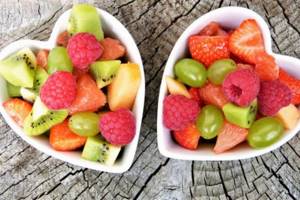
In addition to the permitted foods, when drawing up a low-carbohydrate diet menu for a week for women, it is imperative to take into account those that should not be included in the nutrition plan under any circumstances. This list is quite large and excludes most unhealthy foods that significantly affect weight. So, under no circumstances should you use:
- Any sweets. Moreover, this includes not only sugar and honey, but also sweeteners, even if they are natural and do not contain calories (for example, stevia). Their presence in the diet only supports cravings for sweets that are unnecessary on this diet.
- Bakery products prepared with wheat flour and yeast.
- Carbonated sweet drinks.
- Dairy products that were defatted during production.
- Trans fats found in margarine and fast food.
- Breakfast cereals, muesli, oatmeal and porridge.
- Any pasta, as well as wheat and corn cereals, rice.
- Root vegetables and sweet fruits (even dried fruits).
Different types of flour for cooking
Sesame flour contains quite a lot of vegetable protein. The gluten-free product is rich in vitamin C and minerals. Sesame flour contains a large amount of:
- calcium;
- zinc;
- gland;
- vitamin E.
Coconut flour is made from pre-dried and ground coconut meat. The product does not contain gluten. Coconut flour saturates the body with healthy fiber.
Almond flour has a specific aroma and a characteristic nutty taste. When producing the product, almonds are first blanched and then ground to a powder.
Almond flour comes in different types:
- low fat;
- whole.
Almond flour can be used to make low-carb muffins and pancakes. Pies and pancakes are also made from it.
Menu for a week of the LCHF diet

It can be quite difficult to create the correct menu for a given diet on your own, since you need to correctly calculate the ratio of fats and other substances found in foods. In addition, depending on the severity of your diet, you can vary the amount of carbohydrates slightly if desired. So, if you have just started following such a diet, the best option would be to use this weekly menu of a moderate LCHF diet, which will help painlessly rebuild your body to a new diet. It consists of the following products:
- On the first day, the best option would be to boil a couple of eggs and serve them with sautéed broccoli and spinach cooked in coconut oil. Lunch will consist of a salad with avocado and other non-starchy vegetables to taste with the addition of tuna. For dinner, try salmon with roasted Brussels sprouts.
- It is best to start the second day with a breakfast consisting of full-fat natural yogurt with the addition of pieces of fresh coconut, sliced strawberries and pumpkin seeds. For lunch, turkey or chicken is best, sprinkled with cheese while baking, with chopped tomatoes, cucumbers and peppers as a side dish. For dinner, you should cook a grilled beef steak with roasted bell peppers.
- On the third day, it is recommended to serve a smoothie made with coconut milk with peanut butter and berries for breakfast. If desired, you can add protein powder to it. For grilled lunch you should cook shrimp on skewers with tomatoes and mozzarella. Dine on zucchini noodles with chicken meatballs and pesto sauce.
- Breakfast on the fourth day will consist of a couple of eggs fried in butter, accompanied by a few slices of avocado. For lunch, you can prepare a delicious curry with chicken and cream with the addition of permitted vegetables. For dinner, make your own delicious pizza topped with cauliflower and cheese.
- On day five, the morning begins with a breakfast consisting of a frittata made with cheddar cheese, spinach and onions. For lunch, it's best to have a simple cup of chicken soup with vegetables. But for dinner, treat yourself to moussaka, which is very similar to lasagna, but instead of pasta, use eggplant to separate the layers.
- The sixth day, as reviews about the LCHF diet say, is also best to start with a smoothie. It should consist of coconut milk, berries and cashew nut butter. Lunch includes wraps made with turkey, cheese and avocado. It is recommended to serve them with flaxseed crackers for texture. For dinner, baked trout with fried cauliflower is prepared.
- On the last day, you can serve an omelet of cauliflower, mushrooms and feta for breakfast. For lunch, the best option is chicken breast, which will be stuffed with goat cheese and caramelized onions. But for dinner, prepare yourself a large bowl of green salad with avocado slices, shrimp and pumpkin seeds.
As you can see, the menu for a week of the LCHF diet consists of quite a variety of products that can not only satisfy hunger, but also provide the body with the nutrients and microelements it needs.
Making pumpkin pie
To prepare the crust you need the following products:
- 200 grams of almond flour;
- 150 grams of chopped hazelnuts;
- 1 pack of butter;
- egg yolks (two pieces);
- 1 tablespoon sweetener;
- 1 teaspoon cinnamon;
- a small amount of vanilla.
The filling must be prepared from the following products:
- pulp of one small pumpkin;
- 100 ml cream;
- 140 grams of butter;
- 5 grams of cinnamon;
- ½ dessert spoon of ground ginger.
The sequence for preparing pumpkin pie is as follows:
- You need to take soft butter.
- After this, add flour, sweetener, yolk, vanilla, cinnamon, and yolk. The resulting mass is thoroughly mixed.
- The baking container is covered with parchment paper. Then you need to carefully lay out the dough and level it over the surface of the mold.
- The cake is placed in the oven, which is preheated to a temperature of 170 degrees. It is baked for 10 minutes.
- When preparing the filling, place the pumpkin slices in an oil-soaked frying pan. The vegetable is poured with cream.
- Cover the frying pan with the pumpkin with a lid. The vegetable should be simmered over low heat for 30 minutes.
- Cool the pumpkin and grind it with a mixer to a puree consistency.
- Beat 2 eggs until foamy. The resulting mixture is combined with pumpkin puree.
- After this, sugar, spices and salt are added.
- The resulting filling is transferred to the base of the pie. The dessert is baked for 40 minutes.
Pumpkin pie should be served cold. You can additionally add a little whipped cream.
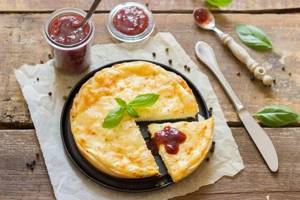
Another menu option

In the future, you can use a more strict LCHF diet, which significantly reduces the amount of carbohydrates allowed. The diet in this case will be as follows:
- On Monday, you can serve a fresh salad for breakfast, consisting of various greens, tomatoes and cucumbers. It is usually served with an omelet. As a snack, you can drink a glass of kefir and eat a few walnuts. For lunch, it is recommended to grill yourself a delicious piece of pork, and add a green salad with celery and suluguni cheese as a side dish. For dinner, the best choice is beef cooked in sour cream sauce with a salad of white cabbage and cucumbers.
- On Tuesday, make yourself a portion of cutlets for breakfast, but steam them. They would be complemented by a salad of green onions, celery and tomatoes, sprinkled with nuts for texture. For a snack, drink a glass of natural full-fat yogurt. For lunch you can eat fried chicken with squash caviar, but for dinner it is recommended to bake duck breast in a sleeve with various vegetables and barbecue sauce to add an original taste and aroma.
- Wednesday morning will begin with a delicious omelet with slices of ham, as well as a salad of tomatoes and cucumbers. During your break, treat yourself to a cheese muffin with sun-dried tomatoes and a glass of kefir. For lunch, pureed zucchini soup and pancakes made from them, for example, with sour cream, are suitable. For dinner, serve pork steak with coleslaw.
- On Thursday, breakfast should consist of dried meat with a piece of hard cheese and fried bacon. During a snack, you should eat some peanuts and drink a glass of kefir. Keep lunch as light as possible by simply grilling vegetables and steaming chicken cutlets. You can have dinner with the leftover pork steak from yesterday, and add a cheesecake and a glass of herbal tea to it.
- On Friday, for breakfast you should serve pancakes made from zucchini and a couple of boiled eggs. For lunch, you can grill meat, and as a side dish make a fresh salad of onions, bell peppers and tomatoes. Pumpkin puree is great as a snack. For dinner, you can eat a selection of suluguni, dried meat, bacon and smoked cheese.
- On your first day off for breakfast, you can treat yourself to a salad of white cabbage, cucumbers and herbs, as well as an omelette with ham and cheese. For lunch you can serve a delicious stew with stewed rabbit and vegetables. But for dinner, grill eggplants and mushrooms, and add baked chicken wings for protein.
- On the last day, have breakfast with pureed zucchini soup, and after a while, eat several zucchini pancakes with sour cream as a snack. You can have lunch with a pork cutlet with a light salad of herbs, tomatoes, celery and nuts. For dinner, a cheese plate with fried bacon is served, as well as kefir with nuts.
Preliminary result
I weighed myself on October 13 in the morning on an empty stomach and got the result of 101 kg (height - 190 cm). Total -6.5 kg for three weeks of nutrition according to the principles of LCHF. And this despite the fact that I was not particularly fat when I started the experiment. True, most of the lost weight is water, which subsided in the amount of 4 liters in the first week of the diet. On the other hand, 2.5 kg of fat in three weeks is also not bad, although it is too fast. Ideally -0.5 kg per week, obviously you still need to work with your diet.
Speaking of diet. In terms of total calorie content, it averaged 3600–3700 kcal/day:

In terms of pure calories (that is, minus physical activity and training, for which additional calories were spent) - 2800 kcal/day , which is slightly (about 300 kcal) higher than my basic costs necessary to support vital functions, taking into account sedentary work, if calculated by Mifflin-San Jeor formula ((9.99 * weight (kg) + 6.25 * height (cm) – 4.92 * age + 5) * 1.2).

Thus, with an average amount of protein of about 230 g per day (2.3 g per kg of body weight) and the indicated calorie content, there are enough resources for the restoration of muscles and other cells of the body and there is even a small reserve.
But this is only in theory. I'll see how it turns out in practice. The weight continues to fall a little, although the muscles do not burn much (on the contrary, the drier they become, the cooler they look), which is visible both visually and by overall strength. On Monday, during leg training, I quite confidently squatted with the usual 120 kg 10-12 times in working approaches.
When the body comes to its senses after a sharp change in diet, finally gets used to the new “protein-fat” realities with virtually no carbohydrates (judging by what I read, this takes about a month), and the weight stops falling, you can try to start gaining training load. In the meantime, I am personally quite pleased with the results. Let's see what will happen next.
Diet Disadvantages and Negative Effects
The LCHF diet has been shown to actually have many health benefits over other low-carb eating plans. However, there are a number of negative aspects that you need to know before using it. First of all, it should never be used by children and adolescents, as well as pregnant and nursing mothers. The only exception here is the need for such nutrition as therapy, and strictly as prescribed by a doctor. Also, only on the recommendations of a specialist, it is worth switching to a similar diet in cases where you have diabetes or various diseases affecting the liver, kidneys or pancreas. Often, such a diet is not suitable for people who are very sensitive to cholesterol, even good cholesterol.
In addition, it is worth paying attention to this fact: despite the fact that the diet is tolerated quite normally by most people, in some cases a number of side effects may occur. These include nausea, weakness, headache, diarrhea, constipation, insomnia, dizziness and even cramps. So, if these side effects begin to appear, you should immediately consult a doctor to find out the causes of the existing problem. If it becomes obvious that the new diet is to blame, you will have to abandon the LCHF diet.
Meat
Suitable meat for LCHF is sufficiently fatty and not seasoned with color fixatives or excess antibiotics. It is impossible to know how many antibiotics there actually are in meat without an independent laboratory, but you can check the composition. Always read the ingredients of the minced meat.
There is debate about the benefits of grass-fed, but if the animal is fed primarily grain, the meat definitely contains Omega 6 fats. If you eat such meat on a regular basis, do not forget about Omega 3 fats.
If little is known about the quality and origin of meat, then it is safer to take lean cuts and add fat during cooking in the form of oil. Animal fat absorbs harmful substances - pesticides and other persistent organic pollutants, protecting the body from their effects.
Toxicological Function of Adipose Tissue: Focus on Persistent Organic Pollutants
It’s better to take raw bacon; in raw smoked bacon you can find sugar, dyes and other ingredients that require the help of Google. The same goes for semi-finished products like sausages and sausages.

There is sugar, no carbohydrates.
Reviews
Based on existing opinions, the LCHF diet is actually quite effective in terms of weight loss. In addition, if you get used to the allowed foods, it will be quite easy to withstand it, because due to the fact that you can eat as much as you want, the feeling of hunger does not affect a person, forcing him to violate his diet. This is what people note in their reviews of the LCHF diet. In addition, relying on fats for energy makes it very difficult to harm the body.
The most difficult thing here is to survive the moment when the weight has stopped on the LCHF diet. It happens to everyone, although the time of its onset depends on the individual characteristics of the body. As soon as you notice that the weight has stopped moving in any direction - lowering or increasing - this will mark the fact that the metabolism begins to gradually rebuild and will act completely differently in the future.
Another unfavorable factor for women at the beginning of following a diet will be the problem with cellulite. At first it will be especially pronounced, but there is no need to worry about this, since the problem will disappear quite quickly. But if this worries you very much, then simply do regular self-massage of problem areas to increase the rate of resorption of fat deposits.
Ketones and health
To keep your body in a safe state of ketosis, you need to carefully track your calories and your protein, fat, and carbohydrate intake. Sometimes ketone levels need to be measured using urine test strips.
Increasing levels of ketone bodies in the blood can change how the body responds to certain medications. Therefore, if you are treating any diseases or taking medications, you should first consult with your doctor whether it is safe for you to lose weight in this way. In addition, without proper monitoring by a nutritionist, you may develop nutritional deficiencies - these are vitamins, minerals and some biologically active compounds.
By the way, the diet also has unpleasant side effects - mental fog, decreased activity and the amount of energy for usual activities. This is how the body adapts to using ketones for energy.
But exercising and leading an active life when your body uses ketones to power your cells instead of the usual glucose can be dangerous. Increasingly, today experts do not recommend using this diet for people who combine nutritional correction and intense sports.
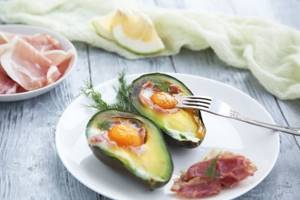
Why I like the keto diet
Thanks to the keto diet, I lost weight easily and painlessly, and I like the way I look. I’ve lost 8 kilograms – I can’t tell you the exact figure, I don’t have a scale, I estimate my current weight by eye.
I have become more cheerful and energetic - I think faster, I remember more, I can walk for hours, and I also got rid of the terrible feeling when in the middle of the day it suddenly starts to “hack”.
I get sick much less often and have gotten rid of allergies. Once, 3 minutes in a minibus next to a cat carrier was enough for me to itch from head to toe, and today the arrogant ginger cat Che is sleeping at my feet. Previously, a sip of coffee made my lips peel, but recently I took the risk of drinking and discovered this delicious world of tastes - how did I live before without a creamy latte?! Oh, and these painful attacks of hunger, when I was ready to kill! Her face is like stone, her chest is bubbling and she wants to rip out the heart of the person she is forced to talk to. Pull it out and eat it. At LCHF, I easily go without food for 7-9 hours, practice intermittent fasting according to the 16/8 pattern, or don’t eat at all for 24 hours. Not a single heart was torn out during this time.

“Is there something? - Che asks. “What if I find it?”
How many times a day do you eat on LCHF?
The need for breakfast is the same myth as the stories about killer fat, the calorie theory, the benefits of fractional meals and the pp pyramid.
Skipping your morning meal is the easiest way to increase your hunger window and burn excess fat. But I have breakfast at 9-10 am. I work from home, so for me this is something of a “divider” of the day.
The second meal is lunch and dinner at 7-8 pm. If the day is long, then at night I can eat a piece of cheese - more out of love for cheese than from hunger.
